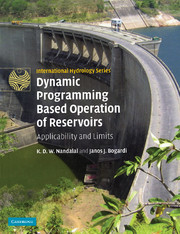Book contents
- Frontmatter
- Contents
- List of figures
- List of tables
- Preface
- 1 Water resources management
- 2 Incremental dynamic programming in optimal reservoir operation
- 3 Stochastic dynamic programming in optimal reservoir operation
- 4 Optimal reservoir operation for water quality
- 5 Large-scale reservoir system operation
- 6 Optimal reservoir operation for flood control
- References
- Index
5 - Large-scale reservoir system operation
Published online by Cambridge University Press: 14 August 2009
- Frontmatter
- Contents
- List of figures
- List of tables
- Preface
- 1 Water resources management
- 2 Incremental dynamic programming in optimal reservoir operation
- 3 Stochastic dynamic programming in optimal reservoir operation
- 4 Optimal reservoir operation for water quality
- 5 Large-scale reservoir system operation
- 6 Optimal reservoir operation for flood control
- References
- Index
Summary
USE OF DYNAMIC PROGRAMMING IN MULTIPLE-RESERVOIR OPERATION
In general, straightforward optimization of multiple-reservoir system operation with DP and SDP does not achieve the accuracy level relevant for real-world applications. The analysis of multiple-reservoir system operation imposes significant dimensionality problems due to the inevitable introduction of three inherent computational difficulties:
(a) Increase in dimensionality of the problem is reflected in the number of state and decision variables necessary to describe a multiple-reservoir system and its operation.
(b) Operation of complex reservoir systems involves multiple, and often noncommensurate objectives. Often these cannot be approximated by a single, clearly defined surrogate objective or criterion.
(c) Additional difficulties arise when it is necessary to consider stochasticity, which is an inherent feature in the operation of reservoir systems. Although it is common to reduce this aspect to river flow uncertainty only, the problem does not seem to be significantly alleviated because multiple reservoirs imply consideration of multiple, independent or cross-correlated, stochastic inflow processes.
Although regarded as a very promising stochastic optimization technique, SDP is still hampered by well-known dimensionality restrictions and the resulting huge computational requirements imposed when applied to multiple-state–multiple-decision problems. In general, and this was also reported by Yeh (1985), systems analysts have opted for one of the following three remedies, or combinations thereof, to overcome these difficulties:
(a) Decomposition of the system into smaller and simpler subsystems thus reducing the complex problem to a set of tractable tasks (e.g., decomposition based on physical or functional structure of the system, multilevel hierarchical decomposition, etc.) (Bogardi and Milutin, 1995; Bogardi et al., 1995; Ampitiya et al., 1996).
[…]
Information
- Type
- Chapter
- Information
- Dynamic Programming Based Operation of ReservoirsApplicability and Limits, pp. 73 - 109Publisher: Cambridge University PressPrint publication year: 2007
